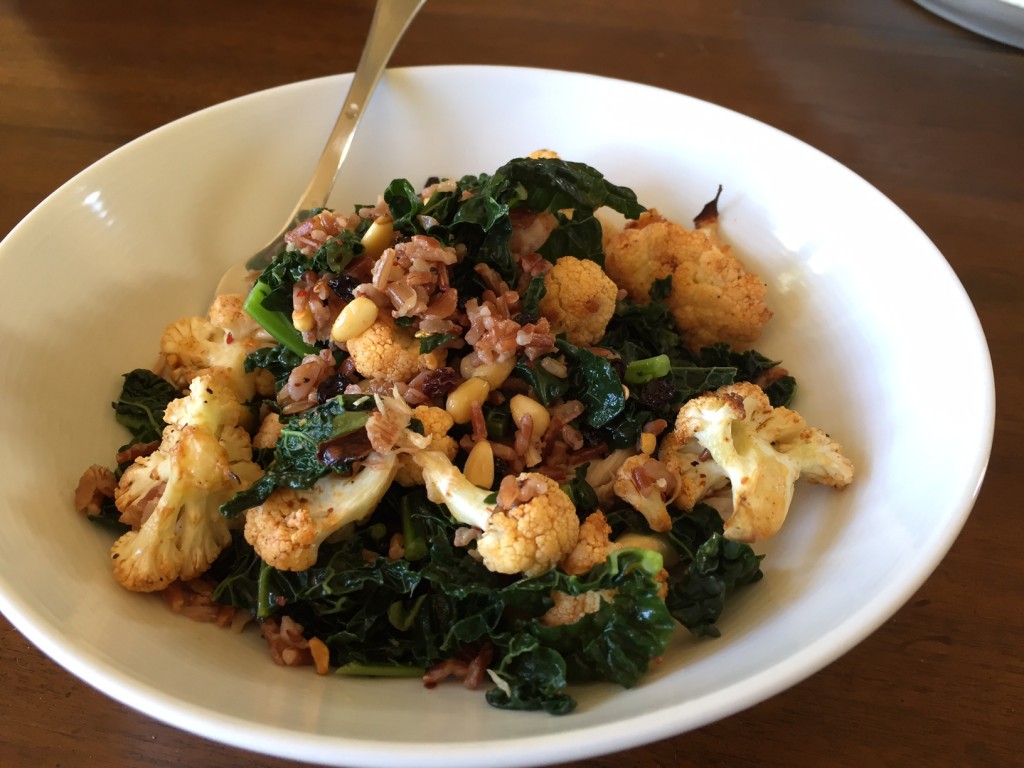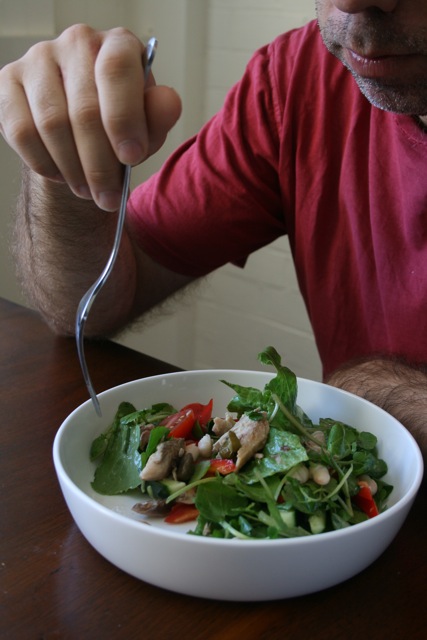This post has been sitting in my drafts folder for well over a year. (Can that really be right? Yes, it is, horrifyingly.) I started writing it when Luciano and Eliane were leaving Brisbane to go back to Brazil. They’d often asked me for recipes for the salads I brought to lab parties, and I wanted to write the recipes down for them as a farewell present. Then I couldn’t work out how to write an intro paragraph that would convey just how much I loved them and would miss them when they left, so I wrote the recipe part, stored it in the drafts folder, and put off writing the personal part. I should have just written “I love you and I’ll miss you!” and published it.
I love the fact that academia has let me be friends with so many lovely people from all over the world, but I hate that everyone (including me) always moves away, eventually. Sure, I now have places to stay in a dozen different countries when I travel, but I’d swap that in a second for all my scattered friends from the last decade or so suddenly deciding to move to Melbourne together. I’m a crappy email correspondent, so I know I don’t say this (or anything else) often enough, but I hope you all know that I miss you like hell.
Anyway, I’m dusting this draft off now because Begoña is going to come over on the weekend to cook with me and we’ll make a couple of salads, so I was looking through my old recipes to work out which ones we might make. Bego, here are some possibilities!
Almost all of the salads I make in this style are just variants of the same master salad, which combines the five components below. They last well, so are good for taking to parties or barbeques, and they’re substantial enough that leftovers make good lunches.
1. A grain. You can use wheat grains, spelt or farro, barley, quinoa (white, red or black, or some combination of the three), cousous, israeli couscous, fregola sarda, burgul, freekeh, red or brown rice, orzo, even ravioli. Cook the grain, drain it, and if you think the grains might stick together, toss it immediately with a little dressing.
2. Vegetables. Raw or cooked, commonly roasted. There should be more vegetable than grain in the salad. I try to chose a seasonal combination from veggies like tomatoes, capsicums, zucchini, eggplant, spinach, chard, radicchio, pumpkin, butternut squash, sweet potato, asparagus, broad beans, peas, mushrooms, cucumbers and fennel.
To roast, I generally cut the vegetable up into small pieces, toss them with oil, salt, pepper, and sometimes a dash of vinegar, spread them out on a baking tray, and cook them in the oven at 180 C until they are browned and softened – 20-60 minutes, depending on the vegetable and the size of the pieces. Make sure you spread them out so they roast rather than steam. I often roast halved tomatoes more slowly at about 110 C, so they lose more of their juice and taste more intense.
3. Herbs. For greenery and flavour. I almost always use chopped soft herbs, especially parsley and mint, but sometimes also chives, basil or dill.
4. Protein. Usually white cheese of some kind (feta, goats cheese, fresh ricotta, ricotta salata), nuts (toasted pine nuts, roughly chopped hazelnuts, slivered almonds), chickpeas, smoked fish, or some combination of these.
5. Dressing. Oil (usually olive oil, but I also sometimes use hazelnut oil or macadamia oil) and acid (usually sherry vinegar, cider vinegar, or lemon juice). Sometimes the residual olive oil and vinegar from the roasted vegetables is suffient; other times I taste the salad and then shake up a little extra oil, vinegar and mustard and stir through. If I’m using a nut oil or lemon juice I add that at the end, rather than during roasting. Occasionally I use home-made pesto, thinned a bit with lemon juice and/or olive oil or a nut oil, as a dressing.
There are infinite variations possible, but here are a few combinations I’ve tried before and liked.
A green and white spring salad
white quinoa, cooked
broad beans, double-podded (or use green peas)
asparagus, blanched or grilled and cut into 3 cm pieces
parsley, mint and chives, finely chopped
preserved lemon, finely chopped
feta
good olive oil, lemon juice and a pinch of salt, mixed to emulsify
Combine everything and toss well. Taste and add more lemon juice or other seasoning as needed. Great eaten with a piece of salmon and maybe some grilled zucchini.
A summer salad with roast vegetables
israeli couscous
ripe roma or cherrry tomatoes, halved and slow-roasted with olive oil and sherry vinegar
slender zucchini, cut into coins about 3 mm thick, tossed with garlic-infused olive oil, salt and pepper, and roasted at 180C till soft and golden
eggplant, sliced, grilled, and cut into pieces
crumbled goats’ cheese or grated ricotta salata
parsley and basil
olive oil and sherry vinegar
Cook the couscous until al dente, drain, then toss with a little olive oil and sherry vinegar to stop it sticking together. Combine with the roasted vegetables, herbs and cheese. The oil and vinegar remaining from cooking the vegetables may be sufficient dressing; if not, whisk up a little more oil and/or vinegar and toss it through.
A quick summer salad
fregola sarda
cucumber, halved lengthways, seeds removed, sliced
sun-dried tomatoes, chopped
avocado, chopped
feta, crumbled
parsley and mint
olive oil and lemon juice, combined
Cook the fregola sarda until al dente. Drain well, then mix with olive oil and lemon juice and set aside. It’s best if you can do this in a wide bowl so it cools quickly. Stir it now and then while it’s cooling, to make sure it doesn’t clump.
Toss the fregola sarda with the vegetables, herbs, cheese and avocado. If the avocado is very ripe it will probably mostly melt into the salad as you toss it, making an almost creamy dressing. Taste for lemon and seasoning and add more if needed.
An autumn salad
barley, cooked and drained
butternut squash, cubed, tossed with garlic olive oil, cider vinegar, salt and pepper, and roasted until softened and browned
slender zucchini, cut into coins about 3 mm thick, tossed with garlic-infused olive oil, salt and pepper, and roasted till soft and golden
chickpeas, cooked (if from a tin, drain and rinse them)
feta or goats’ cheese, crumbled
parsley and chives
olive oil, cider vinegar, seed mustard
Toss the barley with the other ingredients. Make a dressing of olive oil, cider vinegar and a little bit of seed mustard, and toss through.
A winter salad
wheat grains, cooked
kabocha squash, cubed and roasted as for autumn salad
chestnut mushrooms, finely sliced (can either saute or leave them uncooked)
lightly wilted spinach or chard
radicchio, a few torn leaves
hazelnuts, toasted and chopped
aged goats cheese, crumbled
olive oil, hazelnut oil, cider vinegar
Toss the wheat grains with the vegetables, hazelnuts and cheese. Whisk up the dressing of olive oil, hazelnut oil and cider vinegar, and toss through salad.
Other salads in this vein from my archives:
Couscous, chard, feta and pomegranate salad
Red quinoa, cauliflower, green garlic and feta salad
Couscous, eggplant, dried fig and orange salad
Pearl couscous, roast vegetable and harissa salad
Spiced burgul salad
Burgul, tuna and parsley salad
And from elsewhere on the web:
Farro salad with roasted red grapes, kale and swiss chard
Wild rice salad with miso dressing
Bulguf ‘pilaf’ with swiss chard and dried apricots
Quinoa with peas, beans, lemon and herbs
Red quinoa and quail egg salad
Beetroot and moghrabieh salad
Roast cauliflower, chickpea and quinoa salad
Quinoa salad with persian dried lime
Green bean and black quinoa salad
Quinoa with currants, dill and zucchini
Bulgur salad with corn, feta and basil
Brown rice with shiitake, ginger and arame
Hazelnut and chard ravioli salad

